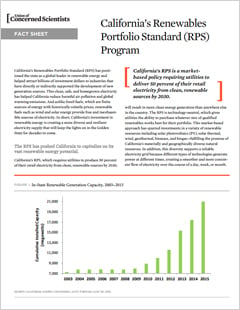California has historically been a leader on clean energy investments, driven in large part by its Renewables Portfolio Standard (RPS).
The California state legislature passed Senate Bill 350 in fall 2015, which requires all utilities in the state to source half of their electricity sales from clean, renewable sources such as wind, solar, geothermal, and biopower, by 2030. UCS work and analysis played an important leadership role in this effort.
How does the RPS benefit Californians?
Since California’s RPS program was created in 2002, nearly 200 new renewable energy generation projects have been built inside the state. Almost three-quarters of these new projects were built in counties with high unemployment levels—6 percent or higher.
Today, the state is generating enough electricity from renewable sources to power more than 5 million homes, and that number is expected to nearly double by 2030.
By displacing electricity generation from coal and natural gas, this clean, safe, and domestic electricity has helped reduce harmful air pollution and global warming emissions.
Unlike fossil fuels, which are finite sources of energy with historically volatile prices, renewables can provide a fixed price and inexhaustible sources of electricity. In short, the RPS is helping California create a more diverse and resilient electricity supply for decades to come.
The RPS also stimulates clean technology investment and innovation. By ensuring that the market for renewable energy in California will continue to grow, the RPS creates a favorable climate for developers, investors, and planners of renewables projects.




